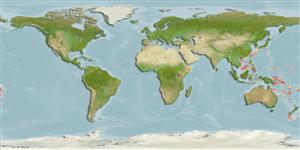Classification / Names
Common names | Synonyms | Catalog of Fishes (gen., sp.) | ITIS | CoL | WoRMS | Cloffa
Elasmobranchii (sharks and rays) >
Carcharhiniformes (Ground sharks) >
Scyliorhinidae (Cat sharks)
Etymology: Cephaloscyllium: Greek, kephale = head + skylion = dogfish (Ref. 80388); stevensi: Named for Dr. John Stevens, whose monumental volume with Peter Last on the sharks of Australia in 1994 was the foundation for research that led to the descriptions of 37 new chondrichthyan fishes, including 11 species of Cephaloscyllium.. More on author: Randall.
Environment / Climate / Range
Ecology
Marine; pelagic-neritic; depth range 240 - 274 m (Ref. 86282). Tropical, preferred ?
Western Pacific: Papua New Guinea.
Size / Weight / Age
Maturity: Lm ? range ? - ? cm
Max length : 66.0 cm TL (female)
Short description
Morphology | Morphometrics
Similar to its congeners, this species is most easily distinguished by its color pattern: gray-brown above, whitish ventrally, mottled with brown and whitish spots of variable size over head and body, including ventrally; 6 large dark brown saddle blotches dorsally on head and body and 3 on caudal fin; first four dorsal dark blotches connecting or leading obliquely to other dark blotches below; small white spots most distinct within or at edges of dark brown blotches (Ref. 86282).
Life cycle and mating behavior
Maturity | Reproduction | Spawning | Eggs | Fecundity | Larvae
Clark, E. and J.E. Randall, 2011. Cephaloscyllium stevensi: a new species of swellshark (Carcharhiniformes: Scyliorhinidae) from Papua New Guinea. aqua, International Journal of Ichthyology 17(1):23-34. (Ref. 86282)
IUCN Red List Status (Ref. 115185)
CITES (Ref. 94142)
Not Evaluated
Threat to humans
Harmless
Human uses
More information
Common namesSynonymsMetabolismPredatorsEcotoxicologyReproductionMaturitySpawningFecundityEggsEgg development
Age/SizeGrowthLength-weightLength-lengthLength-frequenciesMorphometricsMorphologyLarvaeLarval dynamicsRecruitmentAbundance
ReferencesAquacultureAquaculture profileStrainsGeneticsAllele frequenciesHeritabilityDiseasesProcessingMass conversion
Tools
Special reports
Download XML
Internet sources
Estimates of some properties based on models
Phylogenetic diversity index (Ref.
82805): PD
50 = 0.5000 [Uniqueness, from 0.5 = low to 2.0 = high].
Bayesian length-weight: a=0.00324 (0.00157 - 0.00666), b=3.11 (2.93 - 3.29), in cm Total Length, based on LWR estimates for this (Sub)family-body shape (Ref.
93245).
Trophic Level (Ref.
69278): 4.1 ±0.5 se; Based on size and trophs of closest relatives
Resilience (Ref.
69278): Medium, minimum population doubling time 1.4 - 4.4 years (Preliminary K or Fecundity.).
Vulnerability (Ref.
59153): Moderate to high vulnerability (54 of 100) .
